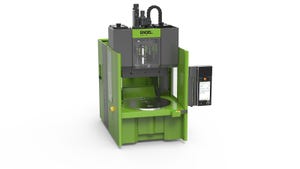What the Denver Broncos can teach us about project management
August 5, 2016

|
Photo courtesy Daniel Spiess/flickr. |
There have been some excellent articles in PlasticsToday describing how some companies have successfully and quickly brought products to market with a roundtable/team approach. The idea here is to get multiple inputs to attain a common goal.
First, let's look at a parallel example: Professional sports. I live in Denver, CO, home of the Broncos. Over the past years, we have had a history of winning the Super Bowl to the point of giving our star players credit for winning. However, that isn't the case. The goal of American football is for your team to score the most points. A supremely talented quarterback will look like the village idiot if:
The offense cannot stop a defensive player from tackling the quarterback before the game-winning pass is thrown.
The other team members create a situation so that the star runner cannot get down field.
When the game-winning pass is airborne, the star receiver has to be in the right place, at the right time, and actually catch the ball and run to the goal line. This requires his talent and the cooperation of his teammates on the field.
In CorpSpeak, this means the “roundtable” includes everyone involved in bringing and keeping the product to market, not only the in-house stakeholders but also the vendors and suppliers.
Both in-house and out-house members have their own agendas, specifically the "what's in it for me" syndrome that operates according to the "three Rs" principle.
Respect: The knowledge that your specific skill is valued.
Recognition: The ego kiss of being pointed out as an example doing the specific job competently.
Reward: Because of 1 and 2, you get a raise, bonus or promotion for your good work.
The problem is that, while the three Rs is a universal concept, each member sees it differently.
Engineering and Design sees success as putting out completed designs on time. Everyone tends to sweep under the rug the tsunami of engineering changes because the design was released “on time,” even if product testing, etc. was only half done.
Purchasing is usually a fatally flawed two-edged sword. The bonus of a buyer is usually determined by how much money he can save his company (his three Rs). Purchasing tends to view its suppliers as sales people at a sleazy used car lot. The tooling buyer—the person who handles the “big bucks”—will go to the low bidder like flies on garbage.
The tooling buyer's assumption is that “tooling is tooling” and his moldmakers are overpriced. This thinking comes from believing that anyone with CNC equipment can make a high-quality mold. Furthermore, if someone in Shenzhen, China, can cut steel 40% cheaper than someone in Chicago, why not go to the less expensive guys? More importantly, he has no concern about the cost or quality of the produced parts.
The part buyer—the lowly commodity purchasing agent—has a view of “parts is parts,” thinking custom molded parts can be produced at the same quality level by anyone with plastic pellets and a molding machine. He also immediately assumes he is being overcharged for the “privilege” of doing business with this company, and begins a highly choreographed assault to lower the cost of what he had initially agreed to as a fair price.
Then we get the “early supplier involvement/partnering” programs. On the surface, this seems an excellent addition to our roundtable: We bring in the mold builder and the molder and have them consult on our designs. They contribute real-world expertise to make our products more manufacturable and economical. However, the sucker punch comes when the buyer explains via “inside” information that he should be the chosen vendor, but will still be cross-quoted "just to keep you honest."
Honest? This is seen as a ruse for free consulting. While it works the first time, it rarely works with any other future requests.
How do we fix this?
Let's go back to the football team and the Super Bowl championship. The reason for success is simple. Every player is a specialist and strives for excellence within his own area of expertise. However, they all focus on the goal of winning the championship first and their own personal glory second.
The same holds with our roundtable team. Yes, when you all work for the same company it is easy to get cooperation. Nevertheless, the whole thing falls apart when outside players have different agendas. Here is the recommendation.
The success of a program is not at product introduction. You should probably declare success a year after initial introduction.
First, we need to fix the politics of the situation. Yes, you still are dealing with two buyers, one for the tooling and another for the parts. Parts are usually 75%+ material cost because of the heavy automation.
Call a meeting with the director of purchasing and ask that the tooling and parts vendor decision be based on the combined cost of the two based on the estimates of resin prices a year out.
The tooling buyer needs to look at the history of initial purchase orders of similar tools from the design team and calculate the percentage of what the engineering changes cost, thereby creating a total tool cost (many times this is 50+% of the initial tooling cost). This number is added to the cost of the first year's estimated production. A more robust mold producing fewer rejects and higher yields might be in the best interests of the company.
With this done, the next step is to get the molder/tool builder team on board for early supplier involvement. Here again it is necessary to interdict any thought of cross quoting these experts. Give them the PO before you invite them to consult based on “budgetary” quotes and their reputations. Their contributions will be in both their interest from a production standpoint and your interest from a part reliability/cost standpoint.
This requires the design/purchasing team to see the three Rs from their supplier's point of view.
Respect: The molder and tool builder expect the respect afforded to a professional. They also have to make a profit. It is not their customer's job to dictate prices�—the marketplace will do that.
Recognition: If treated professionally, your supplier base will be recognized with the status of proudly being one of your “prime suppliers.” Every supplier wants no-hassle customers who pay their bills on time in return for a constant supply of high-quality parts.
Reward: Success is contagious. If your supplier base is not your adversary, it will grow and profit with you. In addition, it will gladly consult to improve your design.
Throw out the idea of supplier management. It is like telling someone you can “manage” your teenage daughters or your pet cat. It does not happen. You can only truly control your supply base if you physically own it.
If you take care of the people who take care of you, and stay away from the people (practices) who don't, the answer to, "What's in it for me?" when we see multiple agendas from the folks we work with is simple: "We win!" In addition, as the Broncos did in the Super Bowl, the entire group then can cash in its own individual three Rs.
Simple, yes? Some companies that quietly do this are wildly successful, while others that believe in management by brute force barely squeak by.
Your choice.
Bill Tobin is a consultant and owner of WJT Associates. He has authored several books and articles and teaches courses on plastics processing. Books, additional articles and the current public training seminar schedule are available at www.wjtassociates.com, or contact the author directly at [email protected].
About the Author(s)
You May Also Like



